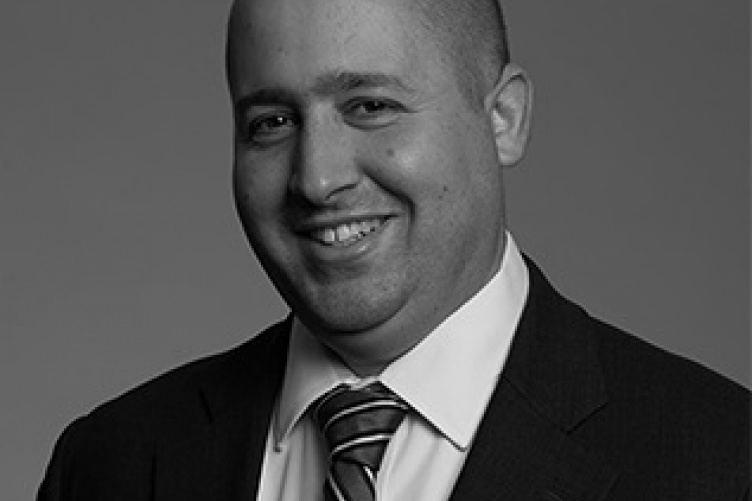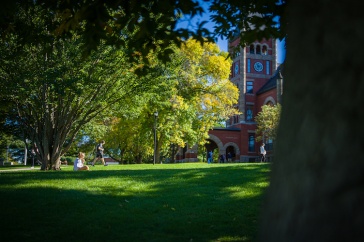
On Oct. 10, 2017, Jonathan Herstoff (JD/LLM ’10) of Haug Partners found himself arguing a case before the U.S. Supreme Court for the first time in his legal career.
He was already familiar with some of the furniture in the room, though.
Herstoff was determined to bury any potential first-time jitters under as much preparation as possible, and his training for the case was so thorough that it included getting acquainted with the lectern itself a week before the trial, thanks to a friendly marshal’s office employee who let him explore the courtroom space during a preparatory visit.
Herstoff certainly looked the part of a veteran in arguing the case – Hamer v. Neighborhood Housing Services of Chicago et al., No. 16-658 (U.S.) – and the preparation ultimately paid off, as the court sided unanimously with his position to secure a victory in his first appearance in front of the justices. The decision is reported at 138 S. Ct. 13 (2017).
“At that level, all eyes are on you. There is less room for error than there would be in another forum,” Herstoff said. “I wanted to make sure I went in there looking like I knew what I was doing, not making any rookie mistakes.”
Herstoff wrote a blog post for Law360.com highlighting his extensive preparation, which included valuable moot court appearances at Cardozo Law – facilitated in part by UNH Law professors Jordan Budd and John Greabe – Public Citizen Litigation Group, and Georgetown Law, along with practice at his firm and at home. It also included the lectern inspection, as Herstoff noted that he’d read one of the “telltale signs that an advocate is presenting argument to the court for the first time is the advocate’s lack of familiarity with the lectern.”
By the time the oral argument began, Herstoff knew how to adjust the stand, and that all of his materials would fit safely on the surface. As he noted in his blog entry, “I wanted to do as much as possible to demonstrate that I had done my homework.”
It was doing his homework that opened the door for Herstoff to argue the case in the first place. Herstoff regularly reviewed decisions on the Seventh Circuit’s website – in order to keep current on developments in the courts of appeals, he wrote – and in doing so came across the case featuring petitioner Charmaine Hamer.
As Herstoff wrote on Law360, the case presented “the question of whether Federal Rule of Appellate Procedure 4(a)(5)(C) affects the jurisdiction of a court of appeals (as the Seventh Circuit concluded), or whether the rule is instead a nonjurisdictional rule that is subject to waiver, forfeiture and equitable considerations.”
Herstoff – who primarily handles Hatch-Waxman patent litigation at Haug Partners, where he’s worked for nearly seven years – was intrigued by the case in part because he’s a “procedure fanatic,” a passion he attributes in part to the training he received at UNH Law. He recalled his civil procedure class during his 1L year with Budd, and also praised professors Tom Field and Buzz Scherr for their influence. Particularly formative was an internship with now-retired Judge Arthur J. Gajarsa of the United States Court of Appeals for the Federal Circuit.
“It was the procedure experiences I had in law school that really piqued my interest,” Herstoff said. “There are a lot of seasoned practitioners on the faculty that are authorities in their field – I went into my career really knowing what practice was going to be like. The experience at the Federal Circuit was amazing. Developing the connection with Judge Gajarsa and being able to complete that internship was an experience I likely wouldn’t have gotten at many other places.”
His draw to the case also included a flashback to research conducted prior to starting law school. The Seventh Circuit’s decision had relied on Bowles v. Russell, 551 U.S. 205 (2007), which was one of the first Supreme Court cases Herstoff read while “figuring out what I was getting myself into” in preparing to begin his law school studies.
Once Herstoff found the case, he contacted Hamer and earned permission from Haug’s pro bono committee to take it on. The work began right away, and it was largely a solo venture for Herstoff, who was granted the autonomy to fully guide the strategy of the petition stage.
When he received the Supreme Court’s grant of certiorari on Feb. 27, 2017, he called it “one of the proudest moments in my professional career.”
“I was off to the races,” he said.
That included setting up the various moot court appearances to prepare for the oral argument, which meant getting on Georgetown’s calendar early – the premier moot court program for Supreme Court cases, Herstoff said Georgetown mooted every single case that was argued in the Supreme Court last year.
Those experiences were invaluable, as was the help he received from his co-workers at Haug as he mooted the case there. He even employed his wife and parents as critical listeners along the way.
“I figured if intelligent non-lawyers could understand my argument, then I was probably on the right track,” Herstoff said.
Oral argument day arrived Oct. 10, 2017, and Herstoff’s argument wound up being the only one on the docket for the day after another was removed from the argument calendar. For that reason, and because he’d spent time at the lectern and prepared thoroughly for months, any nerves Herstoff felt in the days leading up to the argument melted away when he stepped foot in the courtroom.
“I thought coming out of the argument that it was going to go my way, at the very least on the jurisdictionality question,” Herstoff said.
The court ultimately sided with Herstoff and “ruled unanimously that that Rule 4(a)(5)(C) does not affect the jurisdiction of a court of appeals, and therefore remanded the case for further proceedings,” Herstoff wrote at Law360.
“It was extremely exciting for me and my family. It was humbling to get a decision like that, and a unanimous one, in my favor,” Herstoff said. “My client was very excited, as well. I was able to give her the news when the case was granted, and to give her the good news right away when the decision came out – that was really rewarding.”


















































